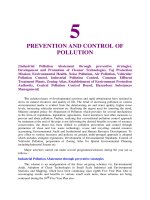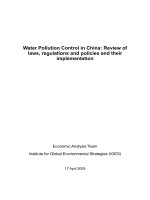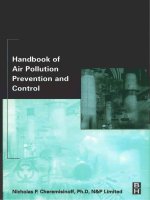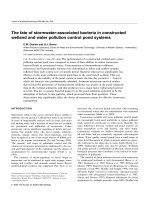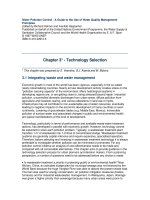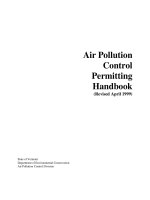handbook of pollution control & waste minimization
Bạn đang xem bản rút gọn của tài liệu. Xem và tải ngay bản đầy đủ của tài liệu tại đây (4.23 MB, 516 trang )
Marcel Dekker, Inc. New York
•
Basel
TM
Abbas Ghassemi
New Mexico State University
Las Cruces, New Mexico
Handbook of
Pollution Control and
Waste Minimization
edited by
Copyright 2002 by Marcel Dekker, Inc. All Rights Reserved.
ISBN: 0-8247-0581-5
This book is printed on acid-free paper.
Headquarters
Marcel Dekker, Inc.
270 Madison Avenue, New York, NY 10016
tel: 212-696-9000; fax: 212-685-4540
Eastern Hemisphere Distribution
Marcel Dekker AG
Hutgasse 4, Postfach 812, CH-4001 Basel, Switzerland
tel: 41-61-261-8482; fax: 41-61-261-8896
World Wide Web
The publisher offers discounts on this book when ordered in bulk quantities. For more
information, write to Special Sales/Professional Marketing at the headquarters address
above.
Copyright © 2002 by Marcel Dekker, Inc. All Rights Reserved.
Neither this book nor any part may be reproduced or transmitted in any form or by any
means, electronic or mechanical, including photocopying, microfilming, and recording, or
by any information storage and retrieval system, without permission in writing from the
publisher.
Current printing (last digit):
10 9 8 7 6 5 4 3 2 1
PRINTED IN THE UNITED STATES OF AMERICA
Copyright 2002 by Marcel Dekker, Inc. All Rights Reserved.
Civil and Environmental Engineering
A Series of Reference Books and Textbooks
Editor
Michael D. Meyer
Department of Civil and Environmental Engineering
Georgia Institute of Technology
Atlanta, Georgia
1. Preliminary Design of Bridges for Architects and Engineers
Michele Melaragno
2. Concrete Formwork Systems
Awad S. Hanna
3. Multilayered Aquifer Systems: Fundamentals and Applications
Alexander H D. Cheng
4. Matrix Analysis of Structural Dynamics: Applications and
Earthquake Engineering
Franklin Y. Cheng
5. Hazardous Gases Underground: Applications to Tunnel
Engineering
Barry R. Doyle
6. Cold-Formed Steel Structures to the AISI Specification
Gregory J. Hancock, Thomas M. Murray, Duane S. Ellifritt
7. Fundamentals of Infrastructure Engineering: Civil Engineering
Systems: Second Edition, Revised and Expanded
Patrick H. McDonald
8. Handbook of Pollution Control and Waste Minimization
edited by Abbas Ghassemi
9. Introduction to Approximate Solution Techniques, Numerical
Modeling, and Finite Element Methods
Victor N. Kaliakin
10. Geotechnical Engineering: Principles and Practices of Soil
Mechanics and Foundation Engineering
V. N. S. Murthy
Additional Volumes in Production
Copyright 2002 by Marcel Dekker, Inc. All Rights Reserved.
Chemical Grouting and Soil Stabilization: Third Edition, Revised
and Expanded
Reuben H. Karol
Estimating Building Costs
Calin M. Popescu, Kan Phaobunjong, Nuntapong Ovararin
Copyright 2002 by Marcel Dekker, Inc. All Rights Reserved.
Foreword
Foreword
Erestor, in Tolkien’s The Lord of the Rings,* declares that only two possibilities
exist for dealing with the menace of the Ring: “to hide it forever, or to unmake
it. But both are beyond our power.” This analogy was used by Amory Lovins in
an unpublished review of proposed U.S. policy on nuclear waste management.
The dilemma described by Erestor is analogous not only to the world’s nuclear
waste issues but to many other concerns related to long-life hazardous waste
being generated worldwide at an alarming rate. Once nuclear or hazardous waste
is produced, we cannot “unmake” it. Congress has responded to these concerns
through a number of legislative initiatives that attempt to minimize the amount
of waste containing hazardous constituents and also place restrictions on its
disposal in underground repositories. In the latter case, the most notable legisla-
tion is the Resource Conservation and Recovery Act (RCRA), requiring that the
best available technology be used to remove the chemical constituents in both
hazardous and mixed waste before it can be permanently disposed of in under-
ground repositories. Compliance with RCRA and other environmental regulations
*The council of Elrond from The Fellowship of the Ring: Lord of the Rings—Part One by J. R. R.
Tolkien, New York: Ballantine Books edn., pp. 349–50, 1986.
Copyright 2002 by Marcel Dekker, Inc. All Rights Reserved.
has come at a high cost in terms of dollars and, sometimes, potential risks to
worker health and safety.
It is with these issues in mind that the editor has compiled a comprehensive
textbook that covers the broad spectrum of pollution prevention including process
design, life cycle analysis, risk and decision analysis. The information presented
will increase awareness of the need to “do it right” the first time. The amount of
waste generated in any process results in a net reduction in profits. In every
process, the ultimate goal is to produce goods and materials that can be sold or
bartered for a profit. Looking into the future, it is ideal to proceed with industrial
development that maximizes the productions of goods and materials while
minimizing or eliminating the waste produced. This includes looking into raw
materials, and production efficiencies as well as process modification and en-
hancement that would result in the ultimate goal. This text encourages future
generations to develop the policies and priorities necessary to effectively deal
with scientific and political issues associated with hazardous and radioactive
waste management.
Jim Bickel
Former Assistant Manager
Projects and Energy Program
U.S. Department of Energy
Ron Bhada
Emeritus Director
WERC
Las Cruces, New Mexico
Copyright 2002 by Marcel Dekker, Inc. All Rights Reserved.
Preface
Preface
The most significant issues facing mankind today are related to the quality of our
environment. Past decisions did not always consider environmental factors as
critical elements. However, current decisions made daily should reflect the
importance of the environment. All environment-related issues are multidiscipli-
nary, ranging from science and engineering to social, economic, and regulatory
issues. Further, these issues are not related to any one region or country, but are
global in nature, requiring multidisciplinary, multiorganizational, and multina-
tional educational efforts.
This book provides an introduction and current information to the academic
community as well as to any professional who must deal with these issues on a
day-to-day basis. My aim is to have environmental issues become a major factor
in process design consideration. Our contributors present the fundamentals of
pollution prevention: life-cycle analysis, designs for the environment, and pollu-
tion prevention in process design. Selected case studies are provided as well.
All of the contributors to this volume are, in one way or another, associated
with WERC, a Consortium for Environmental Education and Technology Devel-
opment program.
The first part of the book deals with elements required for legal, organiza-
tional, and hierarchal components of pollution prevention. Parts II–IV deal with
Copyright 2002 by Marcel Dekker, Inc. All Rights Reserved.
the basics of pollution prevention, leading with fundamentals of pollution preven-
tion, followed by methodology and life cycle cost analysis. Part V deals with risk
and decision fundamentals, as well as, utilization of pollution prevention in
process design. Part VI presents selected case studies in various fields.
As the editor, I realize that I have just begun to scratch the surface with
some of the recent advances. I would like to take this opportunity to thank the
chapter authors for their contributions to this volume. Further gratitude goes to
Dr. Franc Szidarovszky, University of Arizona, and Kay Perkins, WERC, for their
editing assistance.
Abbas Ghassemi
Copyright 2002 by Marcel Dekker, Inc. All Rights Reserved.
Contents
Contents
Foreword Jim Bickel and Ron Bhada
Preface
Contributors
Acronyms
Glossary
Part I Legal/Organizational/Hierarchal Requirements
1 Pollution Prevention and Waste Minimization—Back to Basics
Jeff Weinrach
2 Role of Pollution Prevention in Waste
Management/Environmental Restoration
Harish Chandra Sharma
Copyright 2002 by Marcel Dekker, Inc. All Rights Reserved.
3 The Waste Management Hierarchy
W. David Constant
4 Legislative and Regulatory Issues
Toni K. Ristau
5 Information Systems for Proactive Environmental
Management
Steven P. Frysinger
6 European Policies for Waste Management
Ingo F. W. Romey and Marc Obladen
Part II Fundamentals
7 Energy Conservation
K. A. Strevett, C. Evenson, and L. Wolf
8 Fundamentals of Heat Transfer
René Reyes Mazzoco
9 Macroscopic Balance Equations
Paul K. Andersen and Sarah W. Harcum
10 Biotechnology Principles
Teresa J. Cutright
Part III Methodology
11 Novel Materials and Processes for Pollution Control in the
Mining Industry
Alan Fuchs and Shuo Peng
12 Monitoring In-Situ Electrochemical Sensors
Joseph Wang
13 Using Roadmaps in Pollution Prevention:
The Los Alamos Model
Thomas P. Starke and James H. Scott
14 Pollution Prevention and DFE
Terrence J. McManus
Part IV Life Cycle
15 Pollution Prevention and Life Cycle Assessment
Mary Ann Curran and Rita C. Schenck
Copyright 2002 by Marcel Dekker, Inc. All Rights Reserved.
16 Application of Life Cycle Assessment
W. David Constant
Part V Risk and Decision
17 Risk-Based Pollution Control and Waste Minimization
Concepts
Gilbert J. Gonzales
18 Elements of Multicriteria Decision Making
Abdollah Eskandari, Ferenc Szidarovszky, and Abbas Ghassemi
19 Environmental Considerations and Computer Process Design
Victor R. Vasquez
Part VI Case Studies
20 Minimization and Use of Coal Combustion By-Products (CCBs):
Concepts and Applications
Harold W. Walker, Panuwat Taerakul, Tarunjit Singh Butalia,
William E. Wolfe, and Warren A. Dick
21 Engineered Wetlands for Metal Mining-Impacted
Water Treatment
Herold J. Gerbrandt
22 Fuel Blends and Alkali Diagnostics: European Case Study
Ingo F. W. Romey
23 Best Practices for the Oil and Gas Exploration, Production,
and Pipeline Transportation Industry
Bart Sims
Copyright 2002 by Marcel Dekker, Inc. All Rights Reserved.
Contributors
Contributors
Paul K. Andersen, Ph.D. Associate Professor, Department of Chemical Engi-
neering, New Mexico State University, Las Cruces, New Mexico
Tarunjit Singh Butalia, Ph.D. Research Scientist, Department of Civil and
Environmental Engineering and Geodetic Science, The Ohio State University,
Columbus, Ohio
W. David Constant, Ph.D., P.E. Professor of Civil and Environmental Engi-
neering and Assistant Director of U.S. Environmental Protection Agency Hazard-
ous Substance Research Center/South and Southwest, Department of Civil and
Environmental Engineering, Louisiana State University and A&M College, Baton
Rouge, Louisiana
Mary Ann Curran, M.S. Research Chemical Engineer, Office of Research &
Development, U.S. Environmental Protection Agency, Cincinnati, Ohio
Teresa J. Cutright, Ph.D. Assistant Professor, Department of Civil Engineer-
ing, The University of Akron, Akron, Ohio
Warren A. Dick, Ph.D. Professor of Soil Science, School of Natural Resources,
The Ohio State University, Wooster, Ohio
Copyright 2002 by Marcel Dekker, Inc. All Rights Reserved.
Abdollah Eskandari, Ph.D. Postdoctoral Researcher, Department of Systems
and Industrial Engineering, University of Arizona, Tucson, Arizona
C. Evenson Graduate Degree Candidate, BioEnvironmental Engineering and
Science Laboratory, University of Oklahoma, Norman, Oklahoma
Steven P. Frysinger, Ph.D. Professor, Department of Integrated Science and
Technology, James Madison University, Harrisonburg, Virginia
Alan Fuchs, Ph.D. Assistant Professor, Department of Chemical Engineering,
University of Nevada, Reno, Reno, Nevada
Herold J. Gerbrandt, P.E., Ph.D. Professor, Department of General Engineer-
ing, Montana Tech of the University of Montana, Butte, Montana
Abbas Ghassemi, Ph.D. Executive Director, WERC, New Mexico State Uni-
vesity, Las Cruces, New Mexico
Gilbert J. Gonzales, Ph.D. Ecologist, Ecology Group, Los Alamos National
Laboratory, Los Alamos, and Adjunct Professor, Department of Fishery and
Wildlife Sciences, New Mexico State University, Las Cruces, New Mexico
Sarah W. Harcum, Ph.D. Associate Professor, Department of Chemical Engi-
neering, New Mexico State University, Las Cruces, New Mexico
René Reyes Mazzoco, Ph.D. Professor, Department of Chemical Food and
Engineering, Universidad de las Américas–Puebla, Cholula, Puebla, Mexico
Terrence J. McManus, P.E., D.E.E. Intel Fellow and Director, EHS Technol-
ogies, Corporate Environmental Health and Safety, Intel Corporation, Chandler,
Arizona
Marc Obladen, Ph.D. Scientific Co-Worker, Institute of Technology of Energy
Supply Systems and Energy Conversion Plants, and Professor, University of
Essen, Essen, Germany
Shuo Peng, Ph.D. Research Assistant, Department of Chemical Engineering,
University of Nevada, Reno, Reno, Nevada
Toni K. Ristau, M.S., J.D. Director of Environmental Services, Department of
Power Production and Energy Services, Public Service Company of New Mexico,
Albuquerque, New Mexico
Ingo F. W. Romey, Ph.D. Head of Chair, Institute of Technology of Energy
Supply Systems and Energy Conversion Plants, University of Essen, Essen,
Germany
Rita C. Schenck, Ph.D. Executive Director, Institute for Environmental Re-
search and Education, Vashon, Washington
Copyright 2002 by Marcel Dekker, Inc. All Rights Reserved.
James H. Scott, Ph.D. President, Abaxial Technologies, Los Alamos, New
Mexico
Harish Chandra Sharma, M.S., M.B.A, REM. Site Liaison and Project
Manager, U.S. Department of Energy, Albuquerque, New Mexico
Bart Sims, B.S. Manager, Hazardous Waste and Waste Minimization, Oil and
Gas Division, Environmental Services Section, Railroad Commission of Texas,
Austin, Texas
Thomas P. Starke, Ph.D. Program Manager, Environmental Stewardship Of-
fice, Los Alamos National Laboratory, Los Alamos, New Mexico
K. A. Strevett, Ph.D. Professor of Environmental Engineering, BioEnviron-
mental Engineering and Science Laboratory, University of Oklahoma, Norman,
Oklahoma
Ferenc Szidarovszky, Ph.D. Professor, Department of Systems and Industrial
Engineering, University of Arizona, Tucson, Arizona
Panuwat Taerakul Department of Civil and Environmental Engineering and
Geodetic Science, The Ohio State University, Columbus, Ohio
Victor R. Vasquez, Ph.D. Assistant Professor, Department of Chemical Engi-
neering, University of Nevada, Reno, Reno, Nevada
Harold W. Walker, Ph.D. Assistant Professor, Department of Civil and Envi-
ronmental Engineering and Geodetic Science, The Ohio State University, Colum-
bus, Ohio
Joseph Wang, Ph.D. Professor, Department of Chemistry and Biochemistry,
New Mexico State University, Las Cruces, New Mexico
Jeff Weinrach, Ph.D. Vice President and Director of Quality Standards,
JCS/Novation, Inc., Albuquerque, New Mexico
L. Wolf Graduate Degree Candidate, BioEnvironmental Engineering and Sci-
ence Laboratory, University of Oklahoma, Norman, Oklahoma
William E. Wolfe, Ph.D. Professor, Department of Civil and Environmental
Engineering and Geodetic Science, The Ohio State University, Columbus, Ohio
Copyright 2002 by Marcel Dekker, Inc. All Rights Reserved.
Acronyms
Acronyms
ACAA American Coal Ash
Association
AMD Acid mine drainage
ASTM American Society for Testing
and Materials
C&D Construction and demolition
debris
CCA Clean Air Act
CCB Coal combustion by-product
CDF Code of Federal Regulation
CERCLA Comprehensive Environmen-
tal Response, Compen-
sation, and Liability
Act
CLSM Controlled low-strength
material
D&D Decontamination and
decommissioning
DfE Design for environment
DQO Data quality objective
E&P Exploration and production
E2 Energy efficiency
EA Environmental assessment
EDDS Environmental Decision
Support System(s)
EMIS Environmental Management
Information System(s)
EMS Environmental Management
System(s)
EPCRA Emergency Planning and
Community Right-to-
Know Act
ER Environmental restoration
ERP Enterprise resource
planning
ESP Electrostatic precipitation
FBC Fluidized bed combustion
FGD Flue gas desulfurization
FHWA Federal Highway
Administration
Copyright 2002 by Marcel Dekker, Inc. All Rights Reserved.
GIS Geographic Information
System(s)
IADC International Association of
Drilling Contractors
IEIS Integrated Environmental
Information System(s)
ISO 14001 International Standards
Organization’s stand-
ard for environmental
management systems
Lb/mm BTU Pound per million British
thermal unit
LFA Lime-fly ash-aggregate
LIMB Lime injection multistage
burner
LOI Loss on ignition
LQG Large quantity generator
MSW Municipal solid waste
NAAQS Natural Ambient Air Quality
Standards
NOx Nitrogen oxide
NOV Notice of violation
NPL National Priorities List
NSPS New Source Performance
Standards
OCDO Ohio Coal Development
Office
P2 Pollution prevention
PA Preliminary assessment
PC Pulverized coal
POTW Publicly-owned treatment
works
PPE Personal protective
equipment
PPOA Pollution Prevention
Opportunity
Assessment
Psi Pounds per square inch
PSM Pozzolanic-stabilized
Mixture
RCRA Resource Conservation and
Recovery Act
RI/FS Remedial investigation/
feasibility study
ROI Return on investment
RRC Railroad Commission of
Texas
SI Site investigation
SO2 Sulfur dioxide
SPE Society of Petroleum
Engineers
SR State route
TCLP Toxicity of characteristic
leaching procedure
SWMU Solid waste management
unit
TRI Toxic Release Inventory
US DOE U.S. Department of Energy
US EPA U.S. Environmental
Protection Agency
WM Waste management
Wmin Waste minimization
Copyright 2002 by Marcel Dekker, Inc. All Rights Reserved.
Glossary
Glossary
Anode The positive element of any electrical device from which electricity
flows.
Cathodic protection The negative element that draws current away from pipe
and other metal equipment to protect the pipe or equipment from corrosion.
Centrifugal filter A device that spins a fluid at high speed to separate and
remove materials from the fluid.
Closed-Loop drilling fluid system A system of tanks that contains the drilling
fluid used in drilling an oil or gas well so that drilling fluid is not placed in
conventional pits.
Coalescor panel A device used in fluid separation equipment that stabilizes
fluid flow through the device (e.g., reduced turbulence).
Construction and demolition debris (C&D) Waste building materials, pack-
aging, and rubble resulting from construction, remodeling, repair, and demoli-
tion operations on pavement, houses, commercial buildings, plants, and other
structures.
Copyright 2002 by Marcel Dekker, Inc. All Rights Reserved.
Data quality objective (DQO) Qualitative and quantitative statements derived
from the DQO process that clarify study objectives, define the appropriate type
of data, and specify the tolerable levels of potential decision errors that will be
used as the basis for establishing the quality and quantity of data needed to
support decisions. It provides a systematic procedure for defining the criteria that
a data collection design should satisfy, including when and where to collect
samples, the tolerable level of decision errors for the study, and how many
samples to collect.
Decontamination and decommissioning (D&D) The process of reducing or
eliminating and removing from operation of the process harmful substances, such
as infectious agents, so as to reduce the likelihood of disease transmission from
those substances. After the D&D operation, the process is no longer usable.
Demolition The wrecking or taking out of any load supporting structural
member and any related razing, removing, or stripping of a structure. Also called
Deconstruction.
Design for environment (DfE) It is the systematic consideration of pollution
prevention/waste minimization options during the design consideration of any
process associated with environmental safety and health over the product life
cycle.
Drilling fluid The circulating fluid used in drilling oil and gas wells. Drilling
fluid lubricates the drill bit, carries rock cuttings from the wellbore to the surface,
and controls subsurface formation pressures.
Drilling rig The collection of equipment, such as a derrick, used to drill oil and
gas wells.
Enhanced oil recovery Methods applied to oil and gas reservoirs depleted by
primary production to make them productive once again.
Environmental assessment (EA) Document that briefly provides sufficient
evidence and analysis for determining whether to prepare an environmental
impact statement or a finding of no significant impact. Includes a brief discussion
of the need for the proposal, alternatives as required by EPA regulations, the
environmental impacts of the proposed action and alternatives, and a listing of
agencies and persons consulted.
Flowline The surface pipe through which oil travels from a well to processing
equipment or storage.
Functional unit The measure of a life-cycle system used to base reference
flows in order to calculate inputs and outputs of the system.
Copyright 2002 by Marcel Dekker, Inc. All Rights Reserved.
Hazardous waste Solid waste that is hazardous as defined in Title 40 of the
Code of Federal Regulations (CFR). Hazardous waste is either specifically listed
as such or exhibits a characteristic of hazardous waste as specified in 40 CFR
Part 261, Subparts D and C.
Heat-Medium oil Oil that is used to transfer heat from one medium to another
medium.
ISO International Standards Organization (or International Organization of
Standardization).
ISO 14000 International Standardization of Environmental Management Sys-
tem Standard which is “that part of the overall management system which
includes organizational structure, planning activities, responsibilities, practices,
procedures, processes and resources for developing, implementing, achieving,
reviewing and maintaining the environmental policy.”
Large quantity generator (LQG) A hazardous waste generation site classifi-
cation. In general, LQG sites generate more than 2204 pounds of hazardous waste
each month.
Life (a) Economic: period of time after which a product, machine, or facility should
be discarded because of its excessive costs due to costs or reduced profitability;
(b) Physical: that period of time after which a product, machine, or facility can no
longer be repaired in order to perform its designed function properly.
Life cycle cost Evaluation of the environmental effects associated with any
given activity from the initial gathering of raw materials from the earth to the
point at which all materials are returned to the earth; this evaluation includes all
releases to the air, water, and soil.
Life cycle impact assessment A scientifically based process or model that
characterizes projected environmental and human health impacts based on the
results of the life cycle inventory.
Life cycle inventory An objective, data-based process of quantifying energy
and raw material requirements, air emissions, waterborne effluents, solid waste,
and other environmental releases throughout the life cycle of a project, process,
or activity.
Municipal solid waste (MSW) Residential and commercial solid wastes gen-
erated within a community.
Natural gas processing plant A facility containing equipment and vessels
necessary to purify natural gas and to recover natural gas liquids, such as butane
and propane.
Copyright 2002 by Marcel Dekker, Inc. All Rights Reserved.
Paraffin A heavy, wax-like hydrocarbon commonly found in produced crude
oil. Paraffin often accumulates within wells and the associated surface equipment.
pH A unit of measure of the acid or alkaline condition of a substance. On a
logarithmic scale between 1 and 14, a neutral solution has a pH of 7, acid
solutions are less than 7, and alkaline solutions are greater than 7.
Pipeline compressor station An equipment station on a natural gas pipeline
that uses a device to raise the pressure of the gas in order to move it along the
pipeline.
Pollution prevention The use of materials, processes, or practices that reduce
or eliminate the creation of pollutants or wastes at the source.
Pollution Prevention Opportunity Assessment (PPOA) The systematic pro-
cess of identifying areas, processes, and activities that generate excessive waste
streams or waste by-products for the purpose of substitution, alteration, or
elimination of the waste.
Publicly owned treatment works Any device or system used to treat (includ-
ing recycling and reclamation) municipal sewage or industrial wastes of a liquid
nature and is owned by a State, municipality, intermunicipality, or interstate
agency (defined by Section 502(4) of the Clean Water Act).
Pump-jack A surface unit that imparts a reciprocating motion to a string of rods
that operate a pump in an oil well.
Reagent A substance that, because of the chemical reactions it causes, is used
in analysis and synthesis.
Recycling of materials The use or reuse of a waste as an effective substitute
for a commercial product, as an ingredient, or as feedstock in an industrial or
energy producing process; the reclamation of useful constituent fractions within
a waste material; or removal of contaminants from a waste to allow it to be reused.
This includes recovery for recycling, including composting.
Reserve pit The pit in which a supply of drilling fluid is stored for use in
drilling an oil or gas well. A reserve pit is typically an excavated, earthen-walled
pit, which may be lined to prevent contamination of soil and water.
Return on Investment (ROI) The calculation of time within which the process
would save the initial investment amount if the suggested changes were incorpo-
rated into it. In this calculation, depreciation, project cost, and the useful life are
taken into account.
Copyright 2002 by Marcel Dekker, Inc. All Rights Reserved.
Rod-pump The pump in an oil well that lifts oil to the surface as a result of the
reciprocating action of a rod-string (see also Pump-Jack).
Sand-blasting media Abrasive material used to remove paint and other coating
material from metal surfaces. Sand-blasting media is forced onto the surface using
high air pressure.
Screen-Type filter A filter unit, typically constructed of steel, from which the
screen portion can be removed, cleaned of filtrate, and reused.
Separator A cylindrical or spherical vessel used to isolate the components in
streams of mixed fluids.
Soda ash Sodium carbonate, typically used for pH control.
Sour gas Natural gas that contains hydrogen sulfide or another sulfur com-
pound.
Specific gravity The ratio of the weight of a given volume of a substance at a
given temperature to the weight of an equal volume of a standard substance at
the same temperature.
Strata Distinct beds of rock, which are usually parallel. An individual bed of
rock is a stratum in which the subsurface oil and natural gas are contained within
certain strata.
Sulfur dioxide scrubber A device designed to remove sulfur dioxide from the
exhaust gases of engines.
Thermal destruction Destroying of waste (generally hazardous) in a device
that uses elevated temperatures as the primary means to change the chemical,
physical, or biological character or composition of the waste. Examples of the
processes could be incineration, calcinations, oxidation, and microwave dis-
charge. Commonly used for medical waste.
Toxic release inventory (TRI) Required by EPCRA, it contains information on
approximately 600 listed toxic chemicals that facilities release directly to air,
water, or land or transport off-site.
Turn-key contract For the purpose of drilling an oil or gas well, a contract that
calls for the payment of a stipulated amount to the drilling contractor on
completion of the well. A turn-key contract may be based on a set cost per foot
of well drilled.
Vitrification The process of immobilizing waste that produces a glass-like solid
that permanently captures the radioactive materials.
Copyright 2002 by Marcel Dekker, Inc. All Rights Reserved.
Waste combustion Combustion of waste through elevated temperature and
disposal of the residue so generated in the process. It also may include recovery
of heat for use.
Waste management (WM) Activities associated with the disposition of waste
products after they have been generated, as well as actions to minimize the
production of wastes. This may include storage, treatment, and disposal.
Copyright 2002 by Marcel Dekker, Inc. All Rights Reserved.
1
Pollution Prevention and Waste
Minimization—Back to Basics
Jeff Weinrach
JCS/Novation, Inc., Albuquerque, New Mexico
1 TERMINOLOGY
Prevention, n. (prevent, v.—to keep from occurring; avert; hinder)
Minimization, n. (minimize, v.—to reduce to the smallest possible
amount or degree)
Source, n. any thing or place from which something comes, arises, or is
obtained; origin
Reduction, n. (reduce, v.—to bring down to a smaller extent, size,
amount, number, etc.)
Recycle, n. to treat or process (used or waste materials) so as to make
suitable for reuse
⋅
⋅
⋅
Control, n. (control, v.—to exercise restraint or direction over; dominate;
command: to hold in check; curb; to eliminate or prevent the flourishing
or spread of)
Management, n. (manage, v.—to take charge or care of: to handle, direct,
govern, or control in action or use)
Copyright 2002 by Marcel Dekker, Inc. All Rights Reserved.
Treatment, n. (treat, v.—to subject to some agent or action in order to
bring about a particular result)
⋅
⋅
⋅
Waste, n. (waste, v.—to consume, spend, or employ uselessly or without
adequate return; use to no avail or profit; squander: useless consumption
or expenditure; use without adequate return; an act or instance of
wasting: anything unused, unproductive, or not properly utilized: any-
thing left over or superfluous, as excess material or by-products, not of
use for the work in hand)
⋅
⋅
⋅
Pollution, n. the introduction of harmful substances or products into the
environment
Pollute, v. to make foul or unclean, especially with harmful chemical or
waste products
⋅
⋅
⋅
Process, n. A systematic series of actions directed to some end
⋅
⋅
⋅
System, v. An assemblage or combination of things or parts forming a
complex or unitary whole
Source: The Random House Dictionary of the English Language, 2nd
edition, Unabridged. New York: Random House, 1987.
2 BACKGROUND
We are a society rooted in language: both the words and their meanings. We
choose our words carefully in an attempt to convey the particular meaning that
we have in mind. Often, over time, words will develop a “life” of their own,
and their meanings (as well as their usage) may become murky and indistinct. In
the environmental arena, few words or groups of words have gone through the
constant deluge of interpretation and meaning as “pollution prevention.” Over the
last decade, pollution prevention has gone through an evolutionary process from
specific activities such as solvent substitution (CFCs versus replacement solvents,
as an example) to more systematic approaches that often provide the core element
to cost-effective environmental management systems (EMS).
Throughout this evolutionary process, due primarily to the regulatory
oversight that has placed administrative boundaries on what pollution preven-
tion is and what it is not, the practical issue has not always been the focus
of attention:
Copyright 2002 by Marcel Dekker, Inc. All Rights Reserved.
What are the most cost-effective methods to reduce or eliminate envi-
ronmental impacts without sacrificing health, safety, or other related
concerns?
With the advent of EMS and environmental standards such as the ISO
14000 series, pollution prevention is now more often than not viewed as part of
a systematic approach to environmental improvement that includes planning,
information management, and process management. The last two entries in the
glossary above, “process” and “system,” reflect the conditions under which
pollution prevention is now most practically used.
Many organizations have embraced pollution prevention and have already
addressed or are in the midst of addressing the “low-hanging fruit,” the relatively
easy pollution-prevention activities that often do not require a thorough under-
standing of the processes that are generating the pollutants. A number of articles
in the literature describe success using nonhazardous solvents, for example, for
particular applications such as paint stripping or cleaning parts. As the number of
case studies grows and the nonhazardous solvents are shown to be successful for
particular processes or types of processes, the trust in using these solvents in
similar applications naturally grows as well. But with organizations now looking
for more innovative and cost-effective solutions to reducing waste and ineffi-
ciency, the application of environmental management systems where processes
and systems are key to identifying and implementing opportunities to reduce or
eliminate the waste and the inefficiency is becoming more commonplace.
Nevertheless, it is still helpful to have an understanding of what pollution
prevention is and how it can be applied to reduce or eliminate environmental impacts.
This book will provide many examples of pollution prevention as it relates to
particular processes or industries. The remainder of this chapter will provide an
overview of the various aspects to pollution prevention, with an emphasis on getting
beyond the environmental vernacular and focusing on the practical.
In a simplified way, we can think of pollution prevention in two different
contexts: we can prevent pollutants from being generated in the first place, or we
can prevent the pollutants from being introduced into the environment. In the first
case, if the pollutants are considered waste (which is most often the case), then
preventing these materials from being generated would result in a reduction,
minimization, or elimination of the waste (waste minimization). This usually
provides direct economic benefit, since reducing waste usually coincides with
increased efficiency, productivity, and profitability. In the second case, the
pollutants are still being generated but are not being released to the environment.
This should provide some environmental benefits, since the environment is not
being negatively impacted by these materials. However, the economic benefit
may not be as great, since the wastes need to be stored, treated, or disposed, which
Copyright 2002 by Marcel Dekker, Inc. All Rights Reserved.
